Managerial Accounting Report: Healthscope Remuneration Analysis
VerifiedAdded on 2021/06/18
|17
|3741
|42
Report
AI Summary
This report provides a comprehensive analysis of Healthscope's remuneration framework, focusing on its alignment with executive performance and shareholder interests. The report begins with an executive summary and table of contents, followed by an introduction outlining the report's objectives. A literature review examines various methods for calculating pay-for-performance, including merit salary, incentive pay, and the guidelines of the Australian Shareholders' Association. The report then analyzes Healthscope's remuneration structure, including the roles of the remuneration committee, allocation of executive remuneration, and the mix of performance measures used in STI and LTI plans. Findings highlight the importance of aligning remuneration with long-term shareholder value and the use of both financial and non-financial performance metrics. The report concludes with recommendations for optimizing Healthscope's remuneration strategy. The report provides an in-depth examination of remuneration practices, considering the company's financial performance and strategic goals.
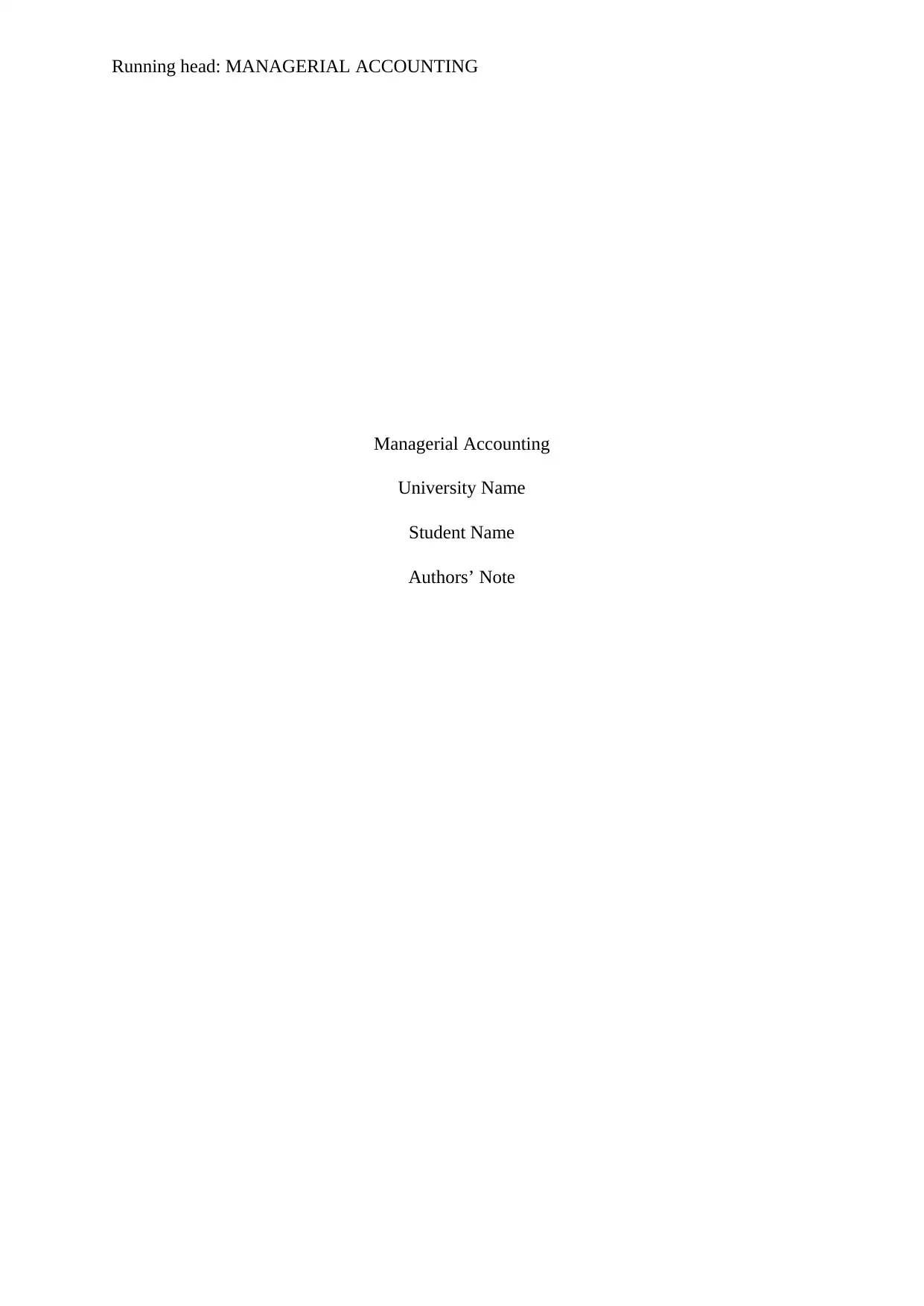
Running head: MANAGERIAL ACCOUNTING
Managerial Accounting
University Name
Student Name
Authors’ Note
Managerial Accounting
University Name
Student Name
Authors’ Note
Paraphrase This Document
Need a fresh take? Get an instant paraphrase of this document with our AI Paraphraser
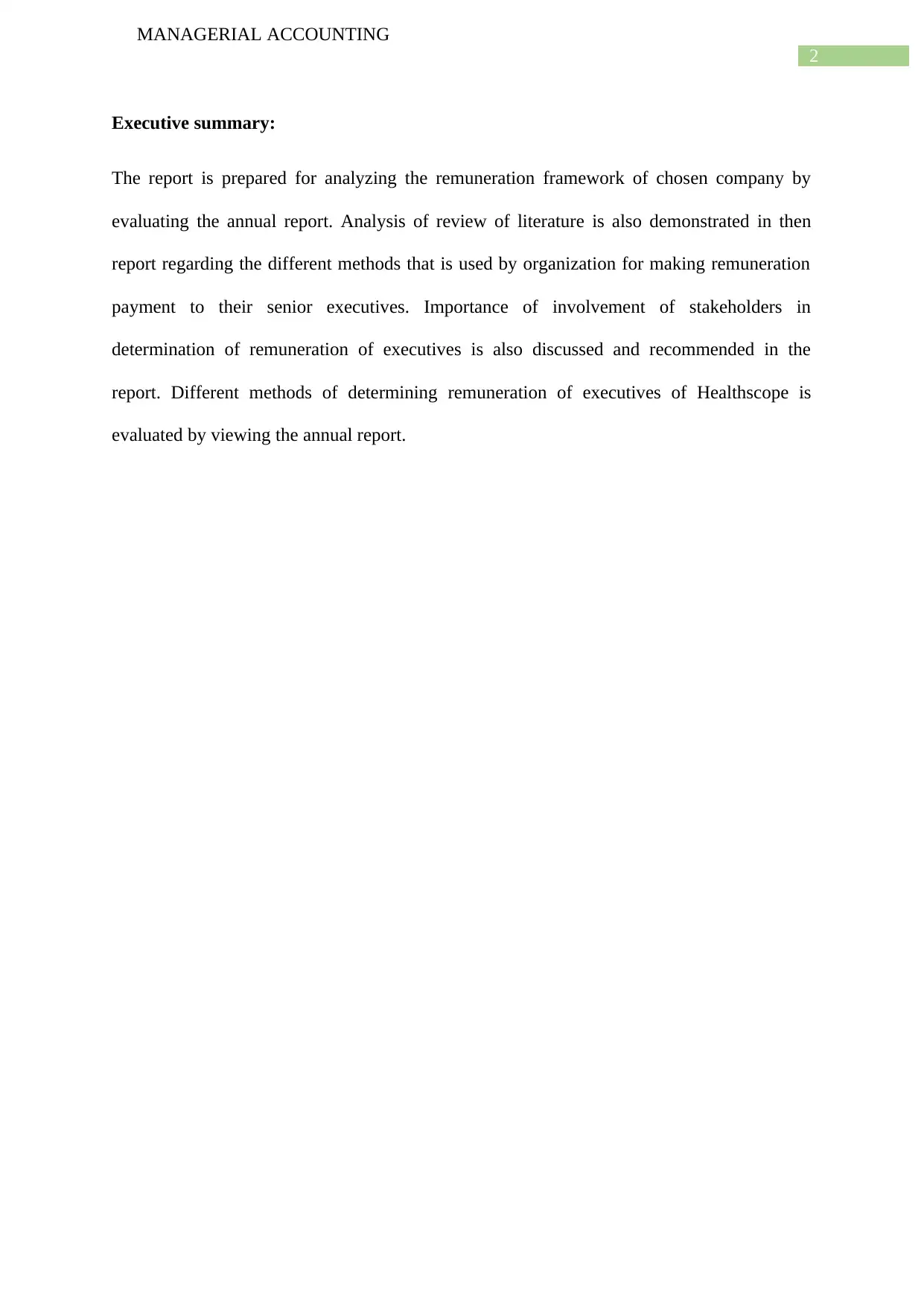
2
MANAGERIAL ACCOUNTING
Executive summary:
The report is prepared for analyzing the remuneration framework of chosen company by
evaluating the annual report. Analysis of review of literature is also demonstrated in then
report regarding the different methods that is used by organization for making remuneration
payment to their senior executives. Importance of involvement of stakeholders in
determination of remuneration of executives is also discussed and recommended in the
report. Different methods of determining remuneration of executives of Healthscope is
evaluated by viewing the annual report.
MANAGERIAL ACCOUNTING
Executive summary:
The report is prepared for analyzing the remuneration framework of chosen company by
evaluating the annual report. Analysis of review of literature is also demonstrated in then
report regarding the different methods that is used by organization for making remuneration
payment to their senior executives. Importance of involvement of stakeholders in
determination of remuneration of executives is also discussed and recommended in the
report. Different methods of determining remuneration of executives of Healthscope is
evaluated by viewing the annual report.
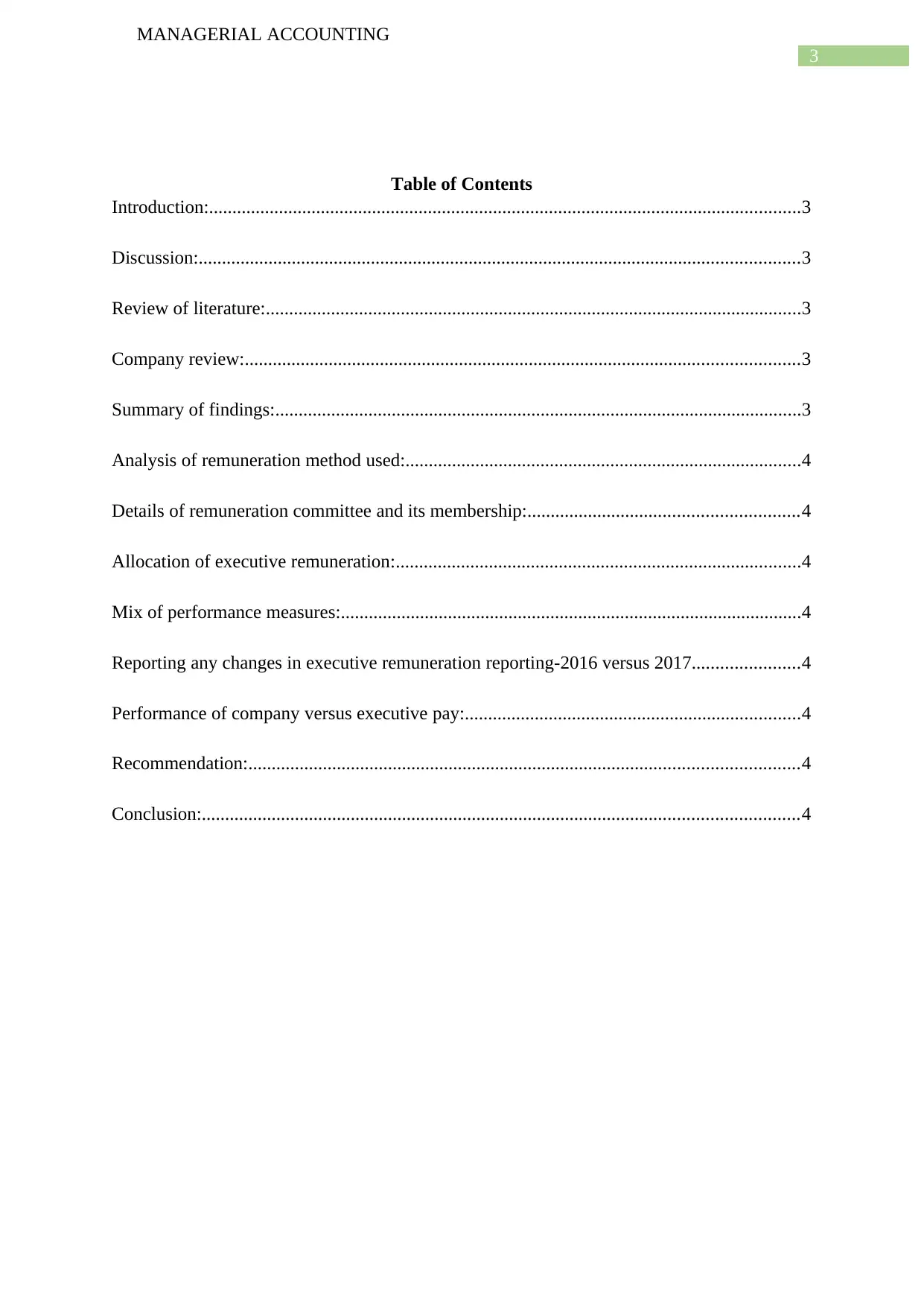
3
MANAGERIAL ACCOUNTING
Table of Contents
Introduction:...............................................................................................................................3
Discussion:.................................................................................................................................3
Review of literature:...................................................................................................................3
Company review:.......................................................................................................................3
Summary of findings:.................................................................................................................3
Analysis of remuneration method used:.....................................................................................4
Details of remuneration committee and its membership:..........................................................4
Allocation of executive remuneration:.......................................................................................4
Mix of performance measures:...................................................................................................4
Reporting any changes in executive remuneration reporting-2016 versus 2017.......................4
Performance of company versus executive pay:........................................................................4
Recommendation:......................................................................................................................4
Conclusion:................................................................................................................................4
MANAGERIAL ACCOUNTING
Table of Contents
Introduction:...............................................................................................................................3
Discussion:.................................................................................................................................3
Review of literature:...................................................................................................................3
Company review:.......................................................................................................................3
Summary of findings:.................................................................................................................3
Analysis of remuneration method used:.....................................................................................4
Details of remuneration committee and its membership:..........................................................4
Allocation of executive remuneration:.......................................................................................4
Mix of performance measures:...................................................................................................4
Reporting any changes in executive remuneration reporting-2016 versus 2017.......................4
Performance of company versus executive pay:........................................................................4
Recommendation:......................................................................................................................4
Conclusion:................................................................................................................................4
⊘ This is a preview!⊘
Do you want full access?
Subscribe today to unlock all pages.

Trusted by 1+ million students worldwide
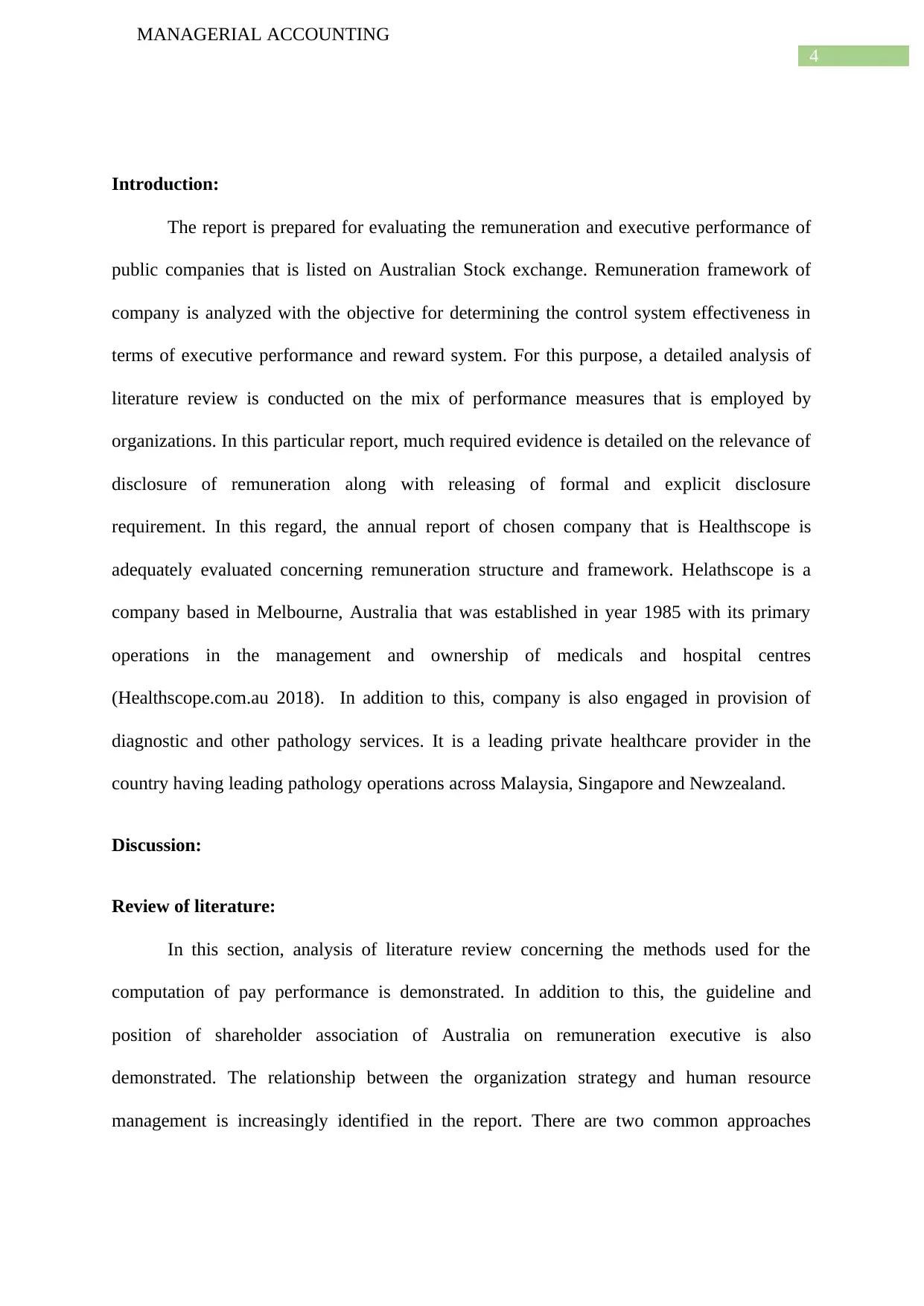
4
MANAGERIAL ACCOUNTING
Introduction:
The report is prepared for evaluating the remuneration and executive performance of
public companies that is listed on Australian Stock exchange. Remuneration framework of
company is analyzed with the objective for determining the control system effectiveness in
terms of executive performance and reward system. For this purpose, a detailed analysis of
literature review is conducted on the mix of performance measures that is employed by
organizations. In this particular report, much required evidence is detailed on the relevance of
disclosure of remuneration along with releasing of formal and explicit disclosure
requirement. In this regard, the annual report of chosen company that is Healthscope is
adequately evaluated concerning remuneration structure and framework. Helathscope is a
company based in Melbourne, Australia that was established in year 1985 with its primary
operations in the management and ownership of medicals and hospital centres
(Healthscope.com.au 2018). In addition to this, company is also engaged in provision of
diagnostic and other pathology services. It is a leading private healthcare provider in the
country having leading pathology operations across Malaysia, Singapore and Newzealand.
Discussion:
Review of literature:
In this section, analysis of literature review concerning the methods used for the
computation of pay performance is demonstrated. In addition to this, the guideline and
position of shareholder association of Australia on remuneration executive is also
demonstrated. The relationship between the organization strategy and human resource
management is increasingly identified in the report. There are two common approaches
MANAGERIAL ACCOUNTING
Introduction:
The report is prepared for evaluating the remuneration and executive performance of
public companies that is listed on Australian Stock exchange. Remuneration framework of
company is analyzed with the objective for determining the control system effectiveness in
terms of executive performance and reward system. For this purpose, a detailed analysis of
literature review is conducted on the mix of performance measures that is employed by
organizations. In this particular report, much required evidence is detailed on the relevance of
disclosure of remuneration along with releasing of formal and explicit disclosure
requirement. In this regard, the annual report of chosen company that is Healthscope is
adequately evaluated concerning remuneration structure and framework. Helathscope is a
company based in Melbourne, Australia that was established in year 1985 with its primary
operations in the management and ownership of medicals and hospital centres
(Healthscope.com.au 2018). In addition to this, company is also engaged in provision of
diagnostic and other pathology services. It is a leading private healthcare provider in the
country having leading pathology operations across Malaysia, Singapore and Newzealand.
Discussion:
Review of literature:
In this section, analysis of literature review concerning the methods used for the
computation of pay performance is demonstrated. In addition to this, the guideline and
position of shareholder association of Australia on remuneration executive is also
demonstrated. The relationship between the organization strategy and human resource
management is increasingly identified in the report. There are two common approaches
Paraphrase This Document
Need a fresh take? Get an instant paraphrase of this document with our AI Paraphraser

5
MANAGERIAL ACCOUNTING
involved in the making payment for individual performance. As reviewed from literature,
there is increase in merit salary popularity and there is decline in popularity of incentive pay.
Incentive pays are the incentive plans that are based on bonus payment of employees
depending on their productivity at work. It is the most direct way employed by organization
for creating link between performance and pay structure and it is evident that individual
behaviour at workplace would be motivated by structure of incentive payment. The reason is
attributable to the fact that deserving employees end up being paid more as this plan helps in
attracting and selecting good performers (Adams 2017). In literature, a detailed description is
provided regarding the plans of incentive pays of the counterproductive behaviours.
There some issues that is associated with the incentive plans such as maintenance
cost, diversified workforce, organization culture and small group’s incentive plans. The
approach of incentive pay is not adopted by several organizations because the negative
impacts of the plan and maintenance cost outweighs the increase in performance by
performance incentives. In some situation, incentive pay is considered as the best fit for
organizations where it is possible to measure the work comprehensively and they are
repetitive, simple and designed for individual. Incentive plan is associated with the
management control approach and it would involve oriented management style that would
stress fairness, due process and participation pay of incentives (Ahmed et al. 2015).
Under this system, there are two types of incentive pay that has been designed and
this involves long term incentive plans (LTI) and short term incentive plans (STI).
LTI are the scheme that helps in establishing relationship between overall long term
performance and bonus schemes as the main focus of such plan is to focus on long term
performance. Some of the plans under this scheme are based on options and stocks. Under
this plan, executives are able to achieve target value for certain measure of performance, they
MANAGERIAL ACCOUNTING
involved in the making payment for individual performance. As reviewed from literature,
there is increase in merit salary popularity and there is decline in popularity of incentive pay.
Incentive pays are the incentive plans that are based on bonus payment of employees
depending on their productivity at work. It is the most direct way employed by organization
for creating link between performance and pay structure and it is evident that individual
behaviour at workplace would be motivated by structure of incentive payment. The reason is
attributable to the fact that deserving employees end up being paid more as this plan helps in
attracting and selecting good performers (Adams 2017). In literature, a detailed description is
provided regarding the plans of incentive pays of the counterproductive behaviours.
There some issues that is associated with the incentive plans such as maintenance
cost, diversified workforce, organization culture and small group’s incentive plans. The
approach of incentive pay is not adopted by several organizations because the negative
impacts of the plan and maintenance cost outweighs the increase in performance by
performance incentives. In some situation, incentive pay is considered as the best fit for
organizations where it is possible to measure the work comprehensively and they are
repetitive, simple and designed for individual. Incentive plan is associated with the
management control approach and it would involve oriented management style that would
stress fairness, due process and participation pay of incentives (Ahmed et al. 2015).
Under this system, there are two types of incentive pay that has been designed and
this involves long term incentive plans (LTI) and short term incentive plans (STI).
LTI are the scheme that helps in establishing relationship between overall long term
performance and bonus schemes as the main focus of such plan is to focus on long term
performance. Some of the plans under this scheme are based on options and stocks. Under
this plan, executives are able to achieve target value for certain measure of performance, they

6
MANAGERIAL ACCOUNTING
are granted with the options or stocks and enabling organization to lower the amount of fixed
costs. LTI intends to create alignment between long term objectives and interest of
shareholder and executives of company. However, this particular approach of scheme comes
with the drawback as employee perceives that performance is associated with reward level.
This is so because such approach is confined towards higher level of executives who directly
impacts the overall performance of company. Employee under such benefits scheme is not
able to derive direct benefits as it creates restriction on liquidity of company (Gitman et al.
2015).
STI are the schemes where the period of performance measurement is usually one
year and employees are paid in cash such as gain share, share of profit, bonus scheme and
commission. The performance criteria under such scheme incorporates qualitative, non
qualitative and some non financial measures. Employees are able to prioritize bottom line and
become well acquainted with the profit margin under the method of profit sharing (Pickering
2017).
It is viewed by the association of Australian shareholder that incentive schemes are
not properly aligned with shareholder returns and they are too often made for less than the
superior performance. The guidelines advocated by the Australian association for LTI plans
are as follows:
LTI involves two components that help in improving the performance of company in
long run. The progress of long term cycle is reflected across business cycle that make
hurdle based on pre set and superior level of increase in company earnings. Making
use of relative total shareholder return against the suitable group of comparator is
another component that is vested at a maximum of 10%.
LTI should be provided to senior executives for creation of shareholder value.
MANAGERIAL ACCOUNTING
are granted with the options or stocks and enabling organization to lower the amount of fixed
costs. LTI intends to create alignment between long term objectives and interest of
shareholder and executives of company. However, this particular approach of scheme comes
with the drawback as employee perceives that performance is associated with reward level.
This is so because such approach is confined towards higher level of executives who directly
impacts the overall performance of company. Employee under such benefits scheme is not
able to derive direct benefits as it creates restriction on liquidity of company (Gitman et al.
2015).
STI are the schemes where the period of performance measurement is usually one
year and employees are paid in cash such as gain share, share of profit, bonus scheme and
commission. The performance criteria under such scheme incorporates qualitative, non
qualitative and some non financial measures. Employees are able to prioritize bottom line and
become well acquainted with the profit margin under the method of profit sharing (Pickering
2017).
It is viewed by the association of Australian shareholder that incentive schemes are
not properly aligned with shareholder returns and they are too often made for less than the
superior performance. The guidelines advocated by the Australian association for LTI plans
are as follows:
LTI involves two components that help in improving the performance of company in
long run. The progress of long term cycle is reflected across business cycle that make
hurdle based on pre set and superior level of increase in company earnings. Making
use of relative total shareholder return against the suitable group of comparator is
another component that is vested at a maximum of 10%.
LTI should be provided to senior executives for creation of shareholder value.
⊘ This is a preview!⊘
Do you want full access?
Subscribe today to unlock all pages.

Trusted by 1+ million students worldwide

7
MANAGERIAL ACCOUNTING
The guidelines advocated by ASA for STI plans are as follows:
Financial performance metrics forms the basis of 50% of STI that is verified by
company in area of responsibility and is based on quantifiable performance indicators.
Equity forms the basis of 50% of STI awards are provided to executives that is
regardless of whether the executives are in the same position.
Company review:
The remuneration structure of Healthscope group is based on performance with the
objective of recognizing and encouraging high performance in a manner that helps in aligning
the long term interests of shareholders and organization as a whole. Outcome of remuneration
is reflecting in the performance when the financial or non financial targets are exceeded or
achieved. It is recognized by the board that it is important to ensure continuous alignment
between shareholder and senior executives. Remuneration arrangement of key management
personnel of Healthscope is detailed in the annual report. It is the responsibility of board to
ensure that structure of remuneration is equitable and well aligned with the long term interest
of stakeholders and organization. Board is further responsible for establishment of
remuneration committee that provides recommendation to the board about incentive
arrangements and fixed remuneration for senior executive and other executives reporting to
CEO. Any major change and development in the incentive plans of employees is also
recommended by the remuneration committee. The incentive plans of organization were
affected in the current year because the financial performance was below target.
STI- The outcome of STI was reduced for participants in corporate roles and such
discretion was exercised by the board. Outcome was reduced to a maximum of 40% of the
target of individual regarding STI opportunity. Such decision was taken by management after
MANAGERIAL ACCOUNTING
The guidelines advocated by ASA for STI plans are as follows:
Financial performance metrics forms the basis of 50% of STI that is verified by
company in area of responsibility and is based on quantifiable performance indicators.
Equity forms the basis of 50% of STI awards are provided to executives that is
regardless of whether the executives are in the same position.
Company review:
The remuneration structure of Healthscope group is based on performance with the
objective of recognizing and encouraging high performance in a manner that helps in aligning
the long term interests of shareholders and organization as a whole. Outcome of remuneration
is reflecting in the performance when the financial or non financial targets are exceeded or
achieved. It is recognized by the board that it is important to ensure continuous alignment
between shareholder and senior executives. Remuneration arrangement of key management
personnel of Healthscope is detailed in the annual report. It is the responsibility of board to
ensure that structure of remuneration is equitable and well aligned with the long term interest
of stakeholders and organization. Board is further responsible for establishment of
remuneration committee that provides recommendation to the board about incentive
arrangements and fixed remuneration for senior executive and other executives reporting to
CEO. Any major change and development in the incentive plans of employees is also
recommended by the remuneration committee. The incentive plans of organization were
affected in the current year because the financial performance was below target.
STI- The outcome of STI was reduced for participants in corporate roles and such
discretion was exercised by the board. Outcome was reduced to a maximum of 40% of the
target of individual regarding STI opportunity. Such decision was taken by management after
Paraphrase This Document
Need a fresh take? Get an instant paraphrase of this document with our AI Paraphraser

8
MANAGERIAL ACCOUNTING
accounting for a range of factors that included the financial performance of group lower than
it is anticipated (Boer et al. 2017).
LTI- The two performance conditions following the testing of performance for the
financial year 2015 of the performance rights of LTI that is earning per share and return to
shareholder return (Leong et al. 2015).
An appropriate focus on internal and external performance was continued to be
provided due to hurdles created by current dual performance. In financial year 2018, the
weighting of measures will be adjusted so that equal weight age will be provided to
performance measure. There is likelihood that such re weighting will help in aligning the
interest of shareholders. Under the LTI plan, there will also be revision of future grants
regarding the EPS target setting practice. This will have three year target for replacing current
approach of cumulative annual target setting. The commitment of Healthscope remained to
providing a retrospective performance disclosure against the metrics of EPS at the end of
each performance period (Maas and Rosendaal 2016).
Remuneration policy of Healthscope intends to ensure that the organization has the
capability of attracting and retaining suitably experienced and qualified personnel.
Summary of findings:
The above section details literature review analysis on the framework of
remuneration and importance of disclosing remuneration in the annual report of organization.
It also elucidates the discussion on the remuneration framework and structure of Healthscope
group. According to review of literature, it can be inferred that computation of incentives are
done using several methods and accordingly it helps in determining the measure of
performance. Nevertheless, there are some considerable differences between the methods of
MANAGERIAL ACCOUNTING
accounting for a range of factors that included the financial performance of group lower than
it is anticipated (Boer et al. 2017).
LTI- The two performance conditions following the testing of performance for the
financial year 2015 of the performance rights of LTI that is earning per share and return to
shareholder return (Leong et al. 2015).
An appropriate focus on internal and external performance was continued to be
provided due to hurdles created by current dual performance. In financial year 2018, the
weighting of measures will be adjusted so that equal weight age will be provided to
performance measure. There is likelihood that such re weighting will help in aligning the
interest of shareholders. Under the LTI plan, there will also be revision of future grants
regarding the EPS target setting practice. This will have three year target for replacing current
approach of cumulative annual target setting. The commitment of Healthscope remained to
providing a retrospective performance disclosure against the metrics of EPS at the end of
each performance period (Maas and Rosendaal 2016).
Remuneration policy of Healthscope intends to ensure that the organization has the
capability of attracting and retaining suitably experienced and qualified personnel.
Summary of findings:
The above section details literature review analysis on the framework of
remuneration and importance of disclosing remuneration in the annual report of organization.
It also elucidates the discussion on the remuneration framework and structure of Healthscope
group. According to review of literature, it can be inferred that computation of incentives are
done using several methods and accordingly it helps in determining the measure of
performance. Nevertheless, there are some considerable differences between the methods of
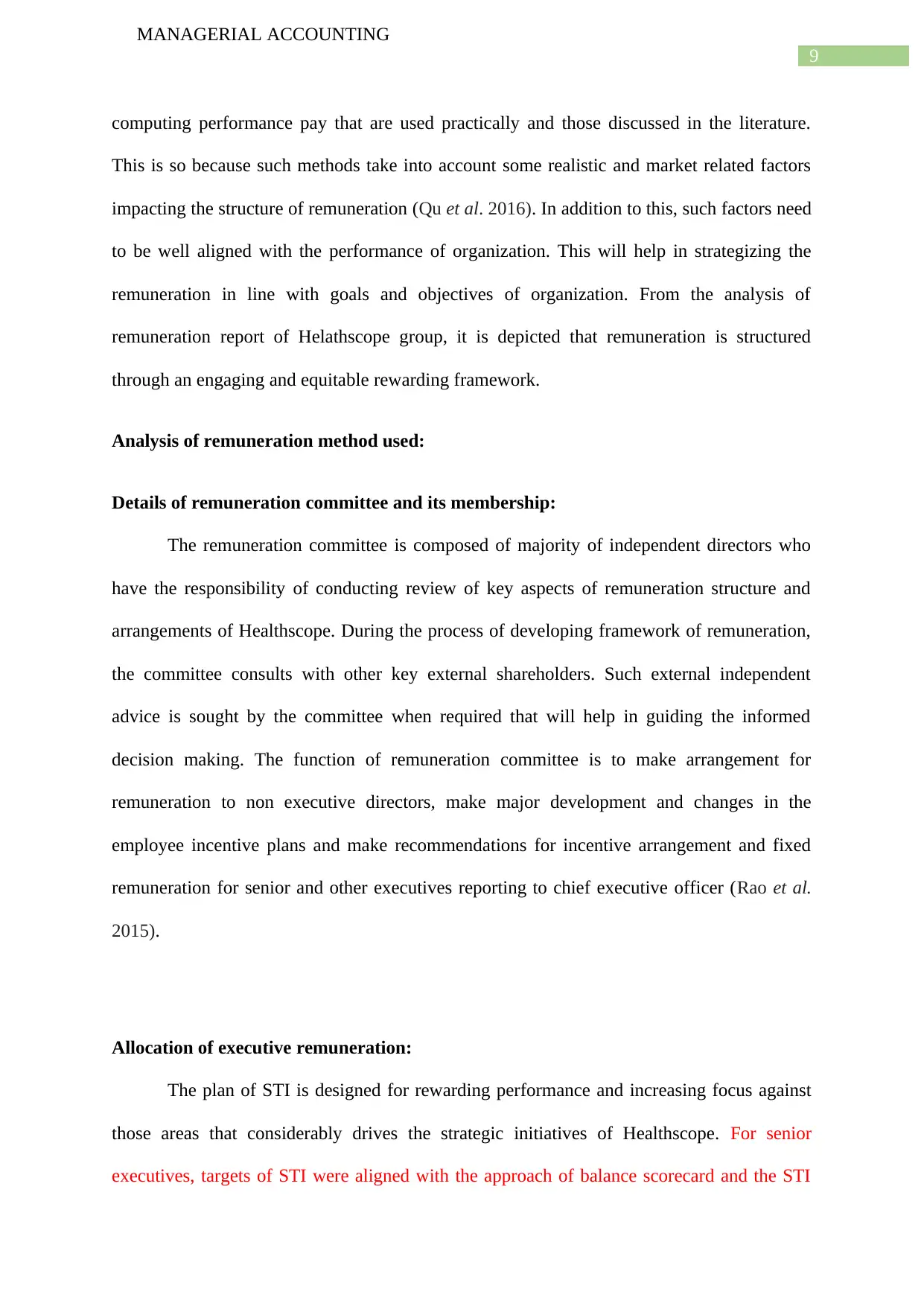
9
MANAGERIAL ACCOUNTING
computing performance pay that are used practically and those discussed in the literature.
This is so because such methods take into account some realistic and market related factors
impacting the structure of remuneration (Qu et al. 2016). In addition to this, such factors need
to be well aligned with the performance of organization. This will help in strategizing the
remuneration in line with goals and objectives of organization. From the analysis of
remuneration report of Helathscope group, it is depicted that remuneration is structured
through an engaging and equitable rewarding framework.
Analysis of remuneration method used:
Details of remuneration committee and its membership:
The remuneration committee is composed of majority of independent directors who
have the responsibility of conducting review of key aspects of remuneration structure and
arrangements of Healthscope. During the process of developing framework of remuneration,
the committee consults with other key external shareholders. Such external independent
advice is sought by the committee when required that will help in guiding the informed
decision making. The function of remuneration committee is to make arrangement for
remuneration to non executive directors, make major development and changes in the
employee incentive plans and make recommendations for incentive arrangement and fixed
remuneration for senior and other executives reporting to chief executive officer (Rao et al.
2015).
Allocation of executive remuneration:
The plan of STI is designed for rewarding performance and increasing focus against
those areas that considerably drives the strategic initiatives of Healthscope. For senior
executives, targets of STI were aligned with the approach of balance scorecard and the STI
MANAGERIAL ACCOUNTING
computing performance pay that are used practically and those discussed in the literature.
This is so because such methods take into account some realistic and market related factors
impacting the structure of remuneration (Qu et al. 2016). In addition to this, such factors need
to be well aligned with the performance of organization. This will help in strategizing the
remuneration in line with goals and objectives of organization. From the analysis of
remuneration report of Helathscope group, it is depicted that remuneration is structured
through an engaging and equitable rewarding framework.
Analysis of remuneration method used:
Details of remuneration committee and its membership:
The remuneration committee is composed of majority of independent directors who
have the responsibility of conducting review of key aspects of remuneration structure and
arrangements of Healthscope. During the process of developing framework of remuneration,
the committee consults with other key external shareholders. Such external independent
advice is sought by the committee when required that will help in guiding the informed
decision making. The function of remuneration committee is to make arrangement for
remuneration to non executive directors, make major development and changes in the
employee incentive plans and make recommendations for incentive arrangement and fixed
remuneration for senior and other executives reporting to chief executive officer (Rao et al.
2015).
Allocation of executive remuneration:
The plan of STI is designed for rewarding performance and increasing focus against
those areas that considerably drives the strategic initiatives of Healthscope. For senior
executives, targets of STI were aligned with the approach of balance scorecard and the STI
⊘ This is a preview!⊘
Do you want full access?
Subscribe today to unlock all pages.

Trusted by 1+ million students worldwide
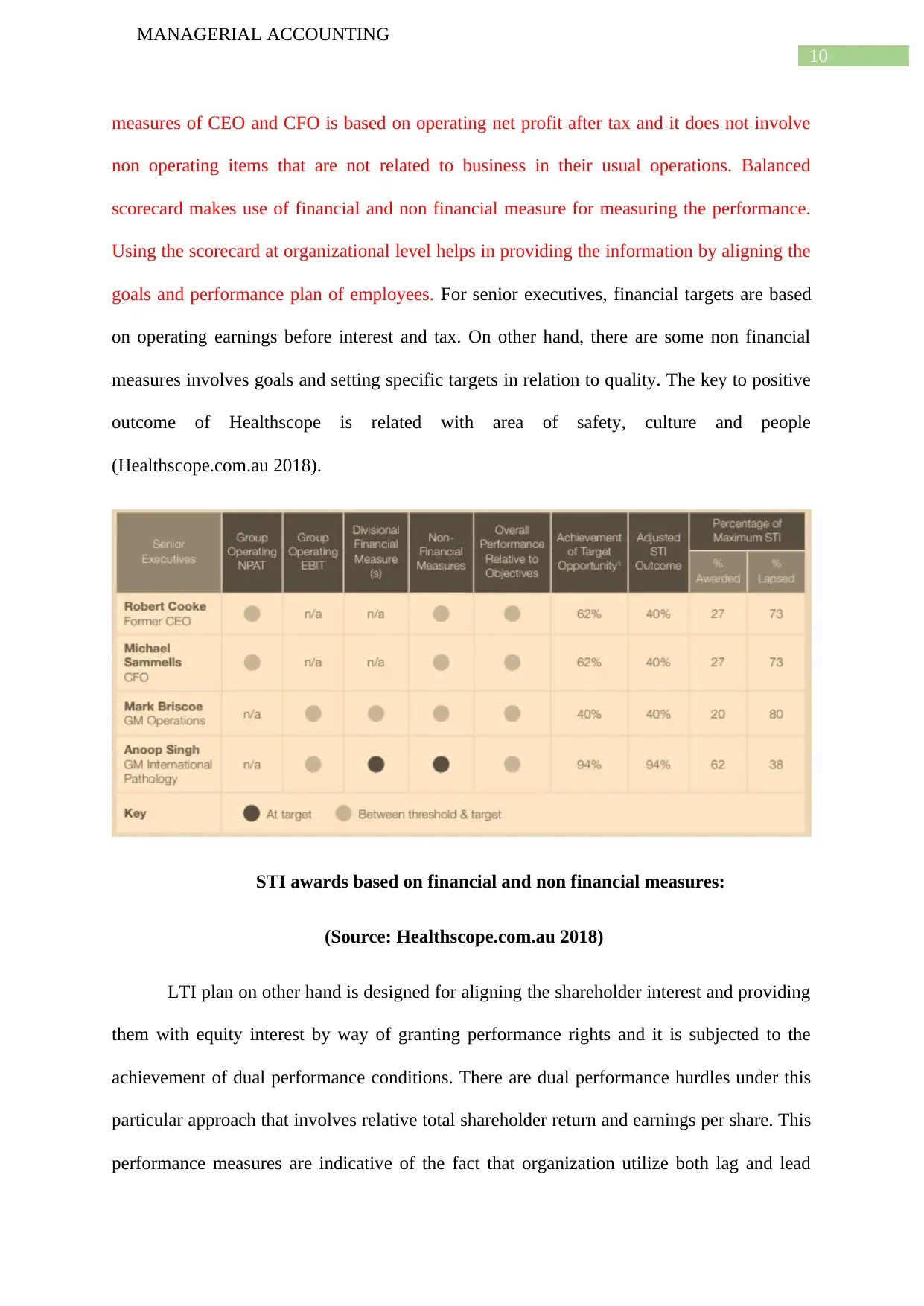
10
MANAGERIAL ACCOUNTING
measures of CEO and CFO is based on operating net profit after tax and it does not involve
non operating items that are not related to business in their usual operations. Balanced
scorecard makes use of financial and non financial measure for measuring the performance.
Using the scorecard at organizational level helps in providing the information by aligning the
goals and performance plan of employees. For senior executives, financial targets are based
on operating earnings before interest and tax. On other hand, there are some non financial
measures involves goals and setting specific targets in relation to quality. The key to positive
outcome of Healthscope is related with area of safety, culture and people
(Healthscope.com.au 2018).
STI awards based on financial and non financial measures:
(Source: Healthscope.com.au 2018)
LTI plan on other hand is designed for aligning the shareholder interest and providing
them with equity interest by way of granting performance rights and it is subjected to the
achievement of dual performance conditions. There are dual performance hurdles under this
particular approach that involves relative total shareholder return and earnings per share. This
performance measures are indicative of the fact that organization utilize both lag and lead
MANAGERIAL ACCOUNTING
measures of CEO and CFO is based on operating net profit after tax and it does not involve
non operating items that are not related to business in their usual operations. Balanced
scorecard makes use of financial and non financial measure for measuring the performance.
Using the scorecard at organizational level helps in providing the information by aligning the
goals and performance plan of employees. For senior executives, financial targets are based
on operating earnings before interest and tax. On other hand, there are some non financial
measures involves goals and setting specific targets in relation to quality. The key to positive
outcome of Healthscope is related with area of safety, culture and people
(Healthscope.com.au 2018).
STI awards based on financial and non financial measures:
(Source: Healthscope.com.au 2018)
LTI plan on other hand is designed for aligning the shareholder interest and providing
them with equity interest by way of granting performance rights and it is subjected to the
achievement of dual performance conditions. There are dual performance hurdles under this
particular approach that involves relative total shareholder return and earnings per share. This
performance measures are indicative of the fact that organization utilize both lag and lead
Paraphrase This Document
Need a fresh take? Get an instant paraphrase of this document with our AI Paraphraser

11
MANAGERIAL ACCOUNTING
indicators. Measure of EPS was chosen because it has lower susceptibility to volatility of
short term share price and correlation with long term return of shareholder
(Healthscope.com.au 2018). The performance of ordinary shares of Helathscope is measured
under relative total shareholder return against the performance of comparator group of
companies. It is believed by the board that this particular measure is an appropriate hurdle as
it helps in creating linkage between relative share performance of company and senior
executive reward. Assessment of performance of RTSR is done independently over the
performance period against the constituents of S&P ASX 100 index. Computation of EPS on
other hand is done by dividing operating net profit after tax by weighted average number of
shares (Healthscope.com.au 2018). Furthermore, it is believed by the board of company that
such methods of assessing the performance are considered as the most appropriate way of
assessing true financial performance and accordingly determining the outcome of
remuneration.
Total remuneration received during financial year 2016-2017 by senior executives:
MANAGERIAL ACCOUNTING
indicators. Measure of EPS was chosen because it has lower susceptibility to volatility of
short term share price and correlation with long term return of shareholder
(Healthscope.com.au 2018). The performance of ordinary shares of Helathscope is measured
under relative total shareholder return against the performance of comparator group of
companies. It is believed by the board that this particular measure is an appropriate hurdle as
it helps in creating linkage between relative share performance of company and senior
executive reward. Assessment of performance of RTSR is done independently over the
performance period against the constituents of S&P ASX 100 index. Computation of EPS on
other hand is done by dividing operating net profit after tax by weighted average number of
shares (Healthscope.com.au 2018). Furthermore, it is believed by the board of company that
such methods of assessing the performance are considered as the most appropriate way of
assessing true financial performance and accordingly determining the outcome of
remuneration.
Total remuneration received during financial year 2016-2017 by senior executives:
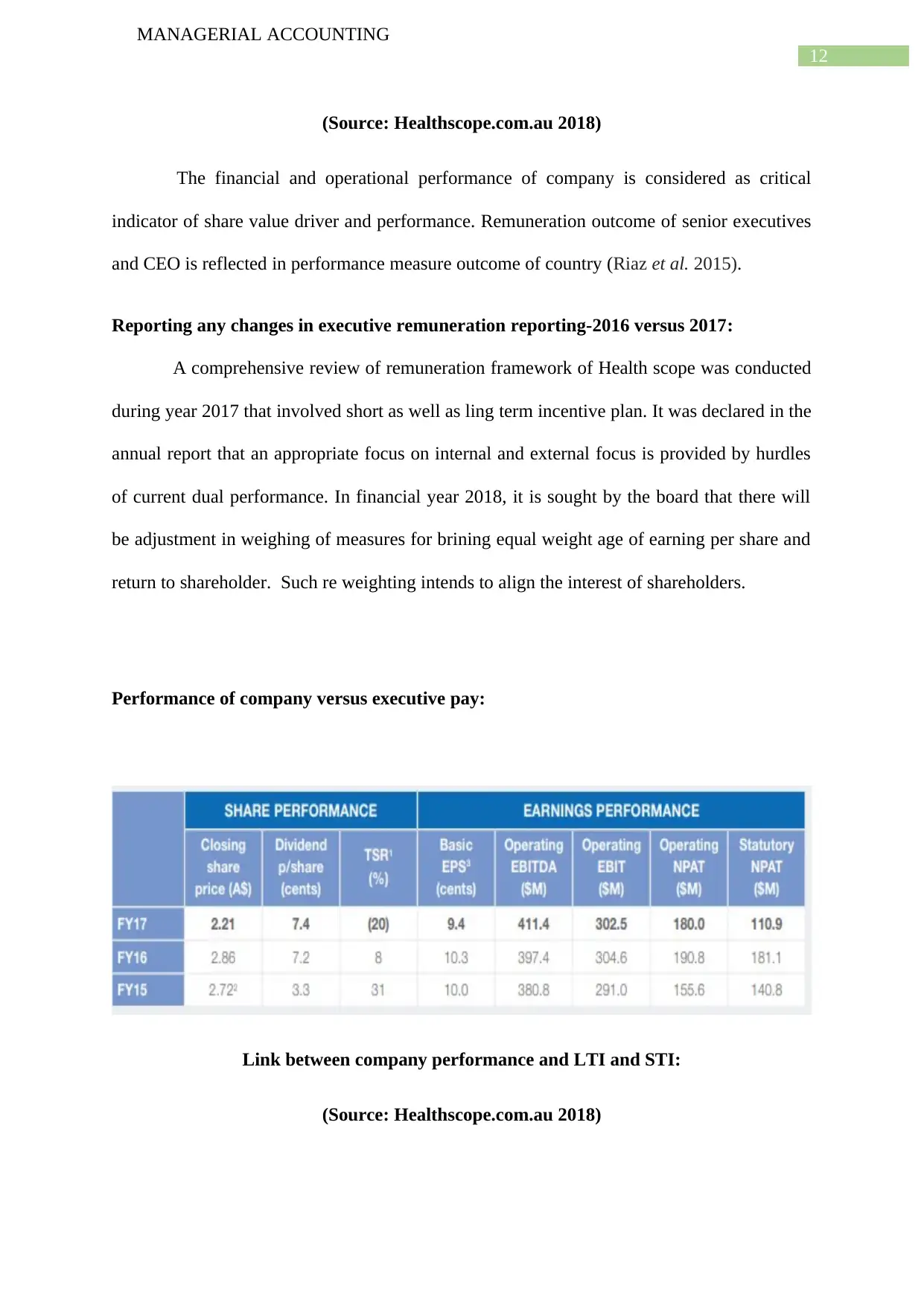
12
MANAGERIAL ACCOUNTING
(Source: Healthscope.com.au 2018)
The financial and operational performance of company is considered as critical
indicator of share value driver and performance. Remuneration outcome of senior executives
and CEO is reflected in performance measure outcome of country (Riaz et al. 2015).
Reporting any changes in executive remuneration reporting-2016 versus 2017:
A comprehensive review of remuneration framework of Health scope was conducted
during year 2017 that involved short as well as ling term incentive plan. It was declared in the
annual report that an appropriate focus on internal and external focus is provided by hurdles
of current dual performance. In financial year 2018, it is sought by the board that there will
be adjustment in weighing of measures for brining equal weight age of earning per share and
return to shareholder. Such re weighting intends to align the interest of shareholders.
Performance of company versus executive pay:
Link between company performance and LTI and STI:
(Source: Healthscope.com.au 2018)
MANAGERIAL ACCOUNTING
(Source: Healthscope.com.au 2018)
The financial and operational performance of company is considered as critical
indicator of share value driver and performance. Remuneration outcome of senior executives
and CEO is reflected in performance measure outcome of country (Riaz et al. 2015).
Reporting any changes in executive remuneration reporting-2016 versus 2017:
A comprehensive review of remuneration framework of Health scope was conducted
during year 2017 that involved short as well as ling term incentive plan. It was declared in the
annual report that an appropriate focus on internal and external focus is provided by hurdles
of current dual performance. In financial year 2018, it is sought by the board that there will
be adjustment in weighing of measures for brining equal weight age of earning per share and
return to shareholder. Such re weighting intends to align the interest of shareholders.
Performance of company versus executive pay:
Link between company performance and LTI and STI:
(Source: Healthscope.com.au 2018)
⊘ This is a preview!⊘
Do you want full access?
Subscribe today to unlock all pages.

Trusted by 1+ million students worldwide
1 out of 17
Related Documents
Your All-in-One AI-Powered Toolkit for Academic Success.
+13062052269
info@desklib.com
Available 24*7 on WhatsApp / Email
![[object Object]](/_next/static/media/star-bottom.7253800d.svg)
Unlock your academic potential
Copyright © 2020–2025 A2Z Services. All Rights Reserved. Developed and managed by ZUCOL.





